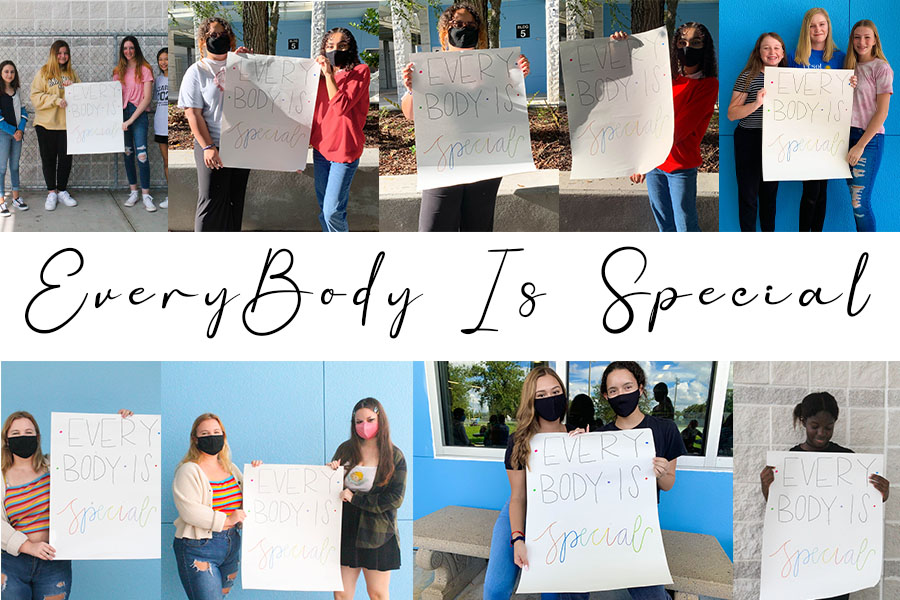Every Body Is Special
September 18, 2020
For upwards of 2,500 years, women have always been subject to impossible beauty standards. These rules actually only apply to about three percent of American females, not even taking into consideration the rest of the world!
Even though this tradition has been around for more than a millennium, this mindset is overall unhealthy and sets a bad example for younger generations.
Women in the U.S. are placed into many categories based on their face shape, body type and skin tone. According to The List, the current perfect female has a bust measurement of 36 inches, a waist measurement of 24 inches and a hip measurement of 36 inches. These proportions create what is called an “hourglass” body shape. The perfect face will typically have a larger/wider forehead and will get more angular towards the chin. These proportions create what is called a “heart” face shape. The combination along with a plethora of other factors creates the “perfect” body type for American women.
“When I was little, I used to look at characters on Disney Channel and think ‘Wow, I wish I looked like them’” Elizabeth Johnson, a sophomore, said. “When I moved to Texas I looked at all the girls in my classes and was intimidated. I wanted to look like them, so I did everything I could too. I would starve myself way too long and I’d work out way too often. When I finally got to my goal weight I felt ‘icky’ and was told that I looked sickly.”
Eating disorders may seem like a small impulse someone has when they are unhappy with the way they look. It is, in fact, quite the opposite. Eating disorders are mental illnesses that affect many people of all ages. Anorexia Nervosa, more commonly known as Anorexia, holds the highest mortality rate of any mental illness. According to the Eating Recovery Center, about 30 million people suffer from eating disorders at least once in their lifetime. There are many factors that can cause these disorders, one leading cause, however, is social media.
Since the creation of social media, there has been a stigma to look a certain way. The message of “Thin Is In” has been embedded in the brains of women of all ages and backgrounds all over the world. Sixty percent of those affected by eating disorders said that the media contributed to the development of their anorexia nervosa.
“It’s really difficult to not see anyone in movies and TV shows who looks like you. I’m a short island girl. My curves distribute differently than others, so I’m curvier than most and I like to eat.” Johnson says, “And I am honestly jealous of little girls today because they have Moana. Something that comes to mind here is Queen Latifah’s character in ‘Hairspray’ She has a line in a song that goes ‘They say that white has might and thin is in, Well that’s just bull’ My sister and I used to watch that movie all the time, that line is something that has always stuck with me. So even though I don’t see a lot of people who look like me, I know that I can one day be the person who kids look up to. And I can use that line to inspire girls and boys everywhere.”
Victoria’s Secret launched “The Perfect Body” campaign in 2014. This advertisement consisted of 10 models, none of which had any “imperfections” on their body. This ad created a commotion because of its tag line. Women are exposed to many advertisements everyday and many people believe that to flat out say Victoria’s Secret models have the perfect body targets insecurities and creates a negative mental image. Aerie launched the “#AerieReal” campaign in 2014. This casts real women as models to use in their advertisements. This campaign includes women of all sizes, skin tones and even some with disabilities. The difference between the two goals of these ads is the messages they present. Victoria’s Secret’s ad targets insecurities and only represents three percent of women. Aerie’s targets empowerment and represents the other 97 percent of women in the world. It is important to represent everyone in the media, especially in modern-day where ads are accessible to everyone.
Some may argue that looking like a model is a sacrifice they are willing to make. However, living up to society’s standards typically isn’t living a healthy lifestyle. The trauma that models and movie stars put their body through, is simply put, dangerous. This trauma is not safe for them, let alone a normal human being.
Body image is a problem that is just now being addressed. It is going to take a long time to remove this ideal from society’s head. But with a little hard work, we can give future generations a chance to see themselves on the television screen.



